child seat CHEVROLET CITY EXPRESS CARGO VAN 2016 1.G Owner's Manual
[x] Cancel search | Manufacturer: CHEVROLET, Model Year: 2016, Model line: CITY EXPRESS CARGO VAN, Model: CHEVROLET CITY EXPRESS CARGO VAN 2016 1.GPages: 297, PDF Size: 4.32 MB
Page 77 of 297
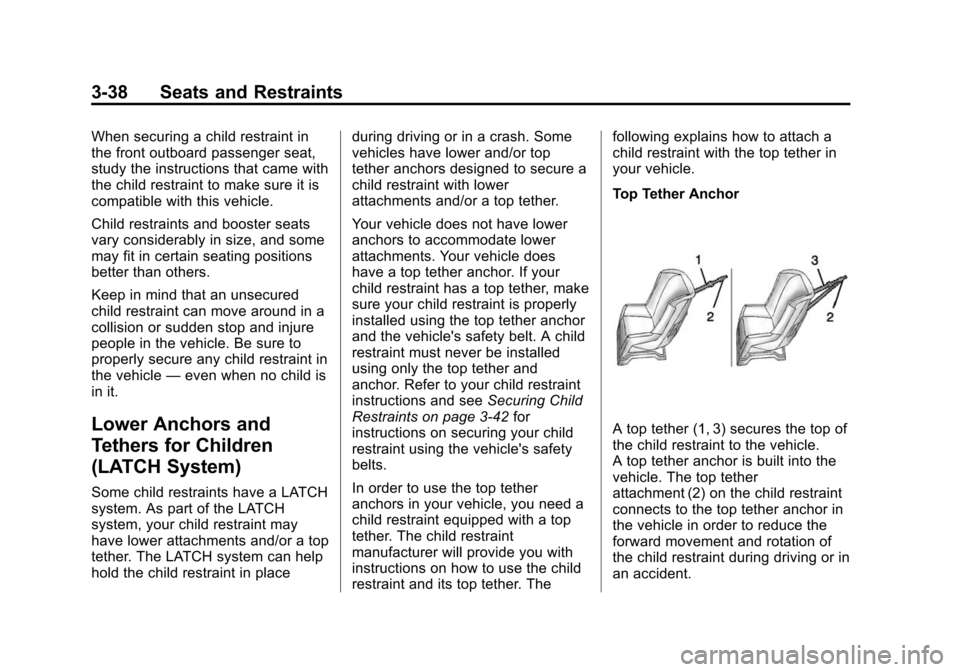
Black plate (38,1)Chevrolet City Express Owner Manual (GMNA-Localizing-U.S./Canada-
7707496) - 2015 - CRC - 11/26/14
3-38 Seats and Restraints
When securing a child restraint in
the front outboard passenger seat,
study the instructions that came with
the child restraint to make sure it is
compatible with this vehicle.
Child restraints and booster seats
vary considerably in size, and some
may fit in certain seating positions
better than others.
Keep in mind that an unsecured
child restraint can move around in a
collision or sudden stop and injure
people in the vehicle. Be sure to
properly secure any child restraint in
the vehicle—even when no child is
in it.
Lower Anchors and
Tethers for Children
(LATCH System)
Some child restraints have a LATCH
system. As part of the LATCH
system, your child restraint may
have lower attachments and/or a top
tether. The LATCH system can help
hold the child restraint in place during driving or in a crash. Some
vehicles have lower and/or top
tether anchors designed to secure a
child restraint with lower
attachments and/or a top tether.
Your vehicle does not have lower
anchors to accommodate lower
attachments. Your vehicle does
have a top tether anchor. If your
child restraint has a top tether, make
sure your child restraint is properly
installed using the top tether anchor
and the vehicle's safety belt. A child
restraint must never be installed
using only the top tether and
anchor. Refer to your child restraint
instructions and see
Securing Child
Restraints on page 3-42 for
instructions on securing your child
restraint using the vehicle's safety
belts.
In order to use the top tether
anchors in your vehicle, you need a
child restraint equipped with a top
tether. The child restraint
manufacturer will provide you with
instructions on how to use the child
restraint and its top tether. The following explains how to attach a
child restraint with the top tether in
your vehicle.
Top Tether Anchor
A top tether (1, 3) secures the top of
the child restraint to the vehicle.
A top tether anchor is built into the
vehicle. The top tether
attachment (2) on the child restraint
connects to the top tether anchor in
the vehicle in order to reduce the
forward movement and rotation of
the child restraint during driving or in
an accident.
Page 78 of 297
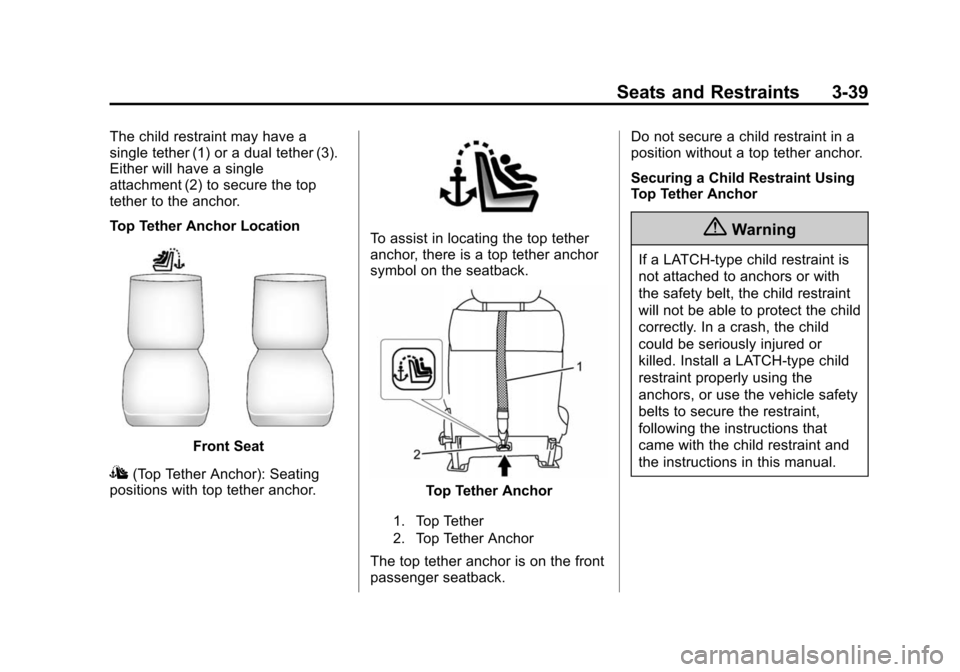
Black plate (39,1)Chevrolet City Express Owner Manual (GMNA-Localizing-U.S./Canada-
7707496) - 2015 - CRC - 11/26/14
Seats and Restraints 3-39
The child restraint may have a
single tether (1) or a dual tether (3).
Either will have a single
attachment (2) to secure the top
tether to the anchor.
Top Tether Anchor Location
Front Seat
I(Top Tether Anchor): Seating
positions with top tether anchor.
To assist in locating the top tether
anchor, there is a top tether anchor
symbol on the seatback.
Top Tether Anchor
1. Top Tether
2. Top Tether Anchor
The top tether anchor is on the front
passenger seatback. Do not secure a child restraint in a
position without a top tether anchor.
Securing a Child Restraint Using
Top Tether Anchor
{Warning
If a LATCH-type child restraint is
not attached to anchors or with
the safety belt, the child restraint
will not be able to protect the child
correctly. In a crash, the child
could be seriously injured or
killed. Install a LATCH-type child
restraint properly using the
anchors, or use the vehicle safety
belts to secure the restraint,
following the instructions that
came with the child restraint and
the instructions in this manual.
Page 79 of 297
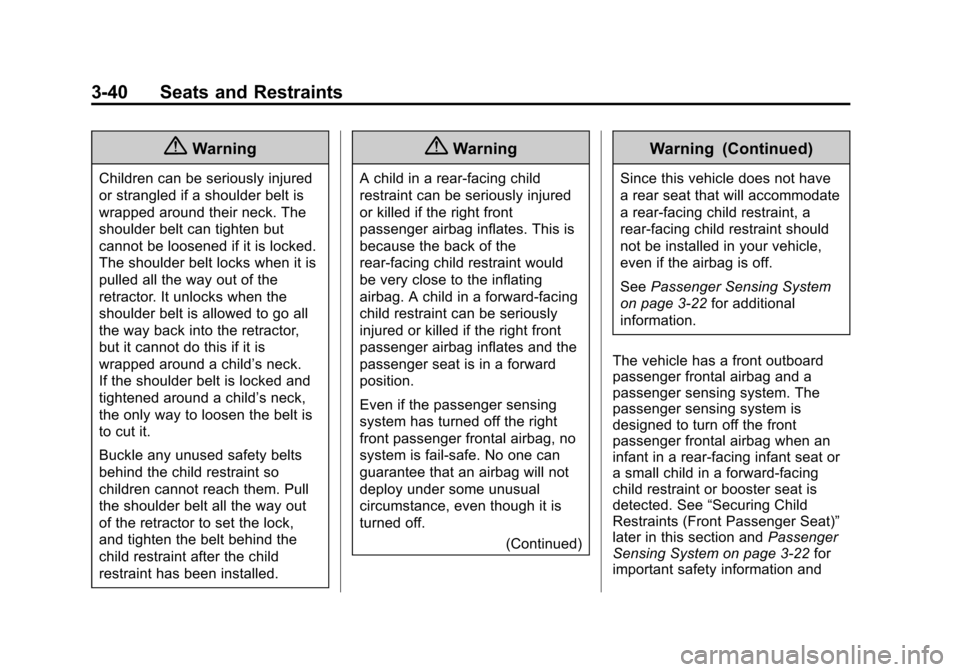
Black plate (40,1)Chevrolet City Express Owner Manual (GMNA-Localizing-U.S./Canada-
7707496) - 2015 - CRC - 11/26/14
3-40 Seats and Restraints
{Warning
Children can be seriously injured
or strangled if a shoulder belt is
wrapped around their neck. The
shoulder belt can tighten but
cannot be loosened if it is locked.
The shoulder belt locks when it is
pulled all the way out of the
retractor. It unlocks when the
shoulder belt is allowed to go all
the way back into the retractor,
but it cannot do this if it is
wrapped around a child’s neck.
If the shoulder belt is locked and
tightened around a child’s neck,
the only way to loosen the belt is
to cut it.
Buckle any unused safety belts
behind the child restraint so
children cannot reach them. Pull
the shoulder belt all the way out
of the retractor to set the lock,
and tighten the belt behind the
child restraint after the child
restraint has been installed.
{Warning
A child in a rear-facing child
restraint can be seriously injured
or killed if the right front
passenger airbag inflates. This is
because the back of the
rear-facing child restraint would
be very close to the inflating
airbag. A child in a forward-facing
child restraint can be seriously
injured or killed if the right front
passenger airbag inflates and the
passenger seat is in a forward
position.
Even if the passenger sensing
system has turned off the right
front passenger frontal airbag, no
system is fail-safe. No one can
guarantee that an airbag will not
deploy under some unusual
circumstance, even though it is
turned off.(Continued)
Warning (Continued)
Since this vehicle does not have
a rear seat that will accommodate
a rear-facing child restraint, a
rear-facing child restraint should
not be installed in your vehicle,
even if the airbag is off.
SeePassenger Sensing System
on page 3-22 for additional
information.
The vehicle has a front outboard
passenger frontal airbag and a
passenger sensing system. The
passenger sensing system is
designed to turn off the front
passenger frontal airbag when an
infant in a rear-facing infant seat or
a small child in a forward-facing
child restraint or booster seat is
detected. See “Securing Child
Restraints (Front Passenger Seat)”
later in this section and Passenger
Sensing System on page 3-22 for
important safety information and
Page 80 of 297
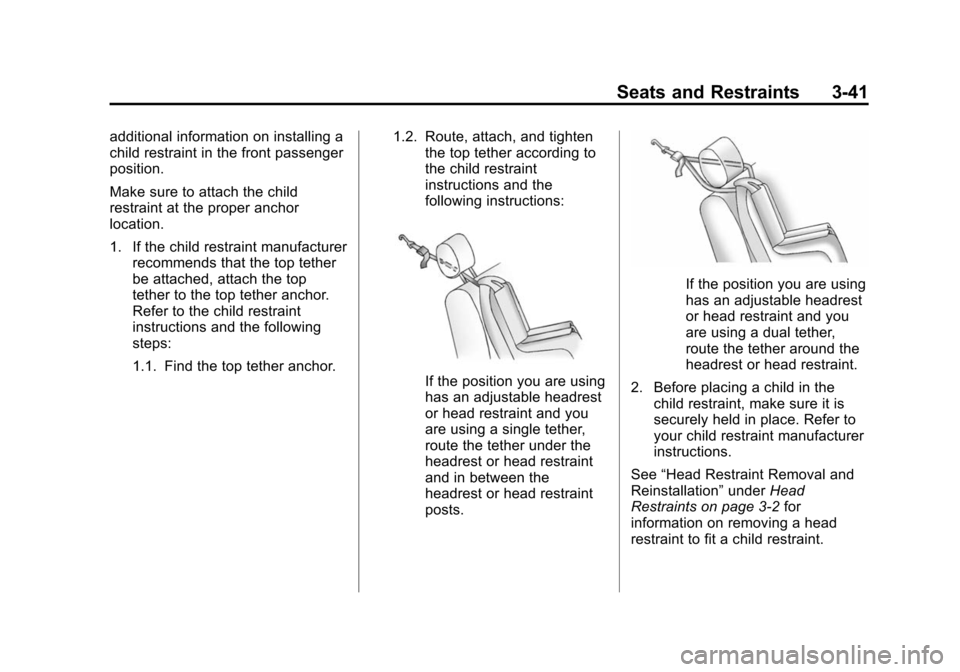
Black plate (41,1)Chevrolet City Express Owner Manual (GMNA-Localizing-U.S./Canada-
7707496) - 2015 - CRC - 11/26/14
Seats and Restraints 3-41
additional information on installing a
child restraint in the front passenger
position.
Make sure to attach the child
restraint at the proper anchor
location.
1. If the child restraint manufacturerrecommends that the top tether
be attached, attach the top
tether to the top tether anchor.
Refer to the child restraint
instructions and the following
steps:
1.1. Find the top tether anchor. 1.2. Route, attach, and tighten
the top tether according to
the child restraint
instructions and the
following instructions:
If the position you are using
has an adjustable headrest
or head restraint and you
are using a single tether,
route the tether under the
headrest or head restraint
and in between the
headrest or head restraint
posts.
If the position you are using
has an adjustable headrest
or head restraint and you
are using a dual tether,
route the tether around the
headrest or head restraint.
2. Before placing a child in the child restraint, make sure it is
securely held in place. Refer to
your child restraint manufacturer
instructions.
See “Head Restraint Removal and
Reinstallation” underHead
Restraints on page 3-2 for
information on removing a head
restraint to fit a child restraint.
Page 81 of 297
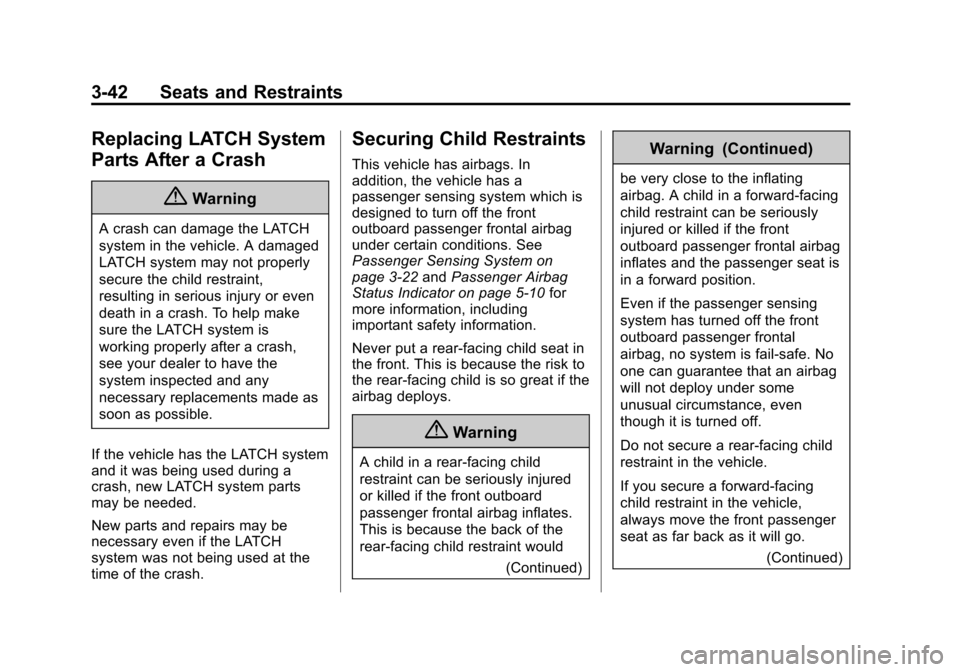
Black plate (42,1)Chevrolet City Express Owner Manual (GMNA-Localizing-U.S./Canada-
7707496) - 2015 - CRC - 11/26/14
3-42 Seats and Restraints
Replacing LATCH System
Parts After a Crash
{Warning
A crash can damage the LATCH
system in the vehicle. A damaged
LATCH system may not properly
secure the child restraint,
resulting in serious injury or even
death in a crash. To help make
sure the LATCH system is
working properly after a crash,
see your dealer to have the
system inspected and any
necessary replacements made as
soon as possible.
If the vehicle has the LATCH system
and it was being used during a
crash, new LATCH system parts
may be needed.
New parts and repairs may be
necessary even if the LATCH
system was not being used at the
time of the crash.
Securing Child Restraints
This vehicle has airbags. In
addition, the vehicle has a
passenger sensing system which is
designed to turn off the front
outboard passenger frontal airbag
under certain conditions. See
Passenger Sensing System on
page 3-22 andPassenger Airbag
Status Indicator on page 5-10 for
more information, including
important safety information.
Never put a rear-facing child seat in
the front. This is because the risk to
the rear-facing child is so great if the
airbag deploys.
{Warning
A child in a rear-facing child
restraint can be seriously injured
or killed if the front outboard
passenger frontal airbag inflates.
This is because the back of the
rear-facing child restraint would
(Continued)
Warning (Continued)
be very close to the inflating
airbag. A child in a forward-facing
child restraint can be seriously
injured or killed if the front
outboard passenger frontal airbag
inflates and the passenger seat is
in a forward position.
Even if the passenger sensing
system has turned off the front
outboard passenger frontal
airbag, no system is fail-safe. No
one can guarantee that an airbag
will not deploy under some
unusual circumstance, even
though it is turned off.
Do not secure a rear-facing child
restraint in the vehicle.
If you secure a forward-facing
child restraint in the vehicle,
always move the front passenger
seat as far back as it will go.(Continued)
Page 82 of 297
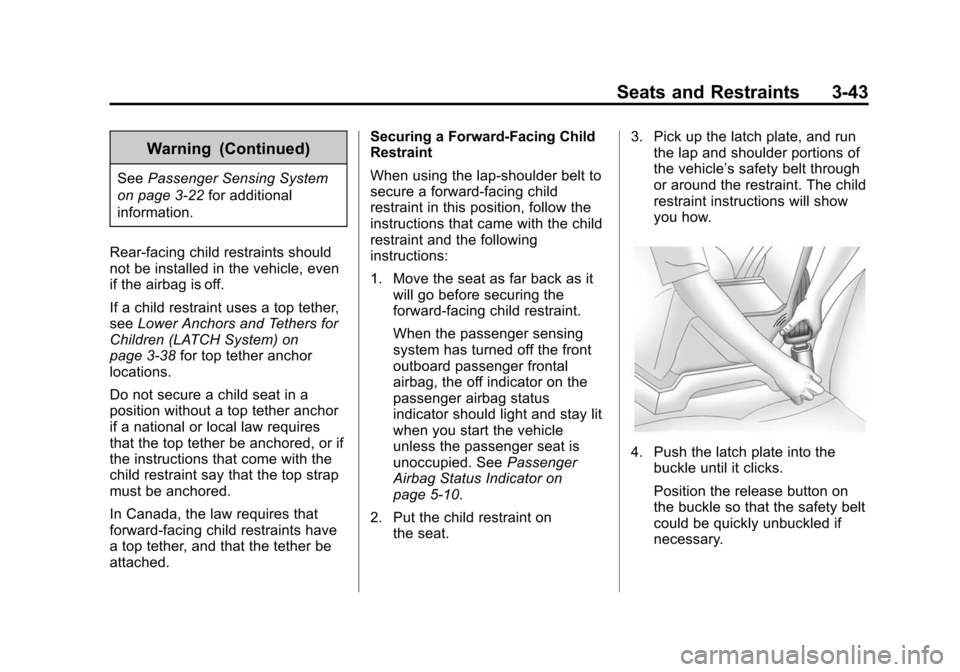
Black plate (43,1)Chevrolet City Express Owner Manual (GMNA-Localizing-U.S./Canada-
7707496) - 2015 - CRC - 11/26/14
Seats and Restraints 3-43
Warning (Continued)
SeePassenger Sensing System
on page 3-22 for additional
information.
Rear-facing child restraints should
not be installed in the vehicle, even
if the airbag is off.
If a child restraint uses a top tether,
see Lower Anchors and Tethers for
Children (LATCH System) on
page 3-38 for top tether anchor
locations.
Do not secure a child seat in a
position without a top tether anchor
if a national or local law requires
that the top tether be anchored, or if
the instructions that come with the
child restraint say that the top strap
must be anchored.
In Canada, the law requires that
forward-facing child restraints have
a top tether, and that the tether be
attached. Securing a Forward-Facing Child
Restraint
When using the lap-shoulder belt to
secure a forward-facing child
restraint in this position, follow the
instructions that came with the child
restraint and the following
instructions:
1. Move the seat as far back as it
will go before securing the
forward-facing child restraint.
When the passenger sensing
system has turned off the front
outboard passenger frontal
airbag, the off indicator on the
passenger airbag status
indicator should light and stay lit
when you start the vehicle
unless the passenger seat is
unoccupied. See Passenger
Airbag Status Indicator on
page 5-10.
2. Put the child restraint on the seat. 3. Pick up the latch plate, and run
the lap and shoulder portions of
the vehicle’ s safety belt through
or around the restraint. The child
restraint instructions will show
you how.
4. Push the latch plate into the buckle until it clicks.
Position the release button on
the buckle so that the safety belt
could be quickly unbuckled if
necessary.
Page 83 of 297
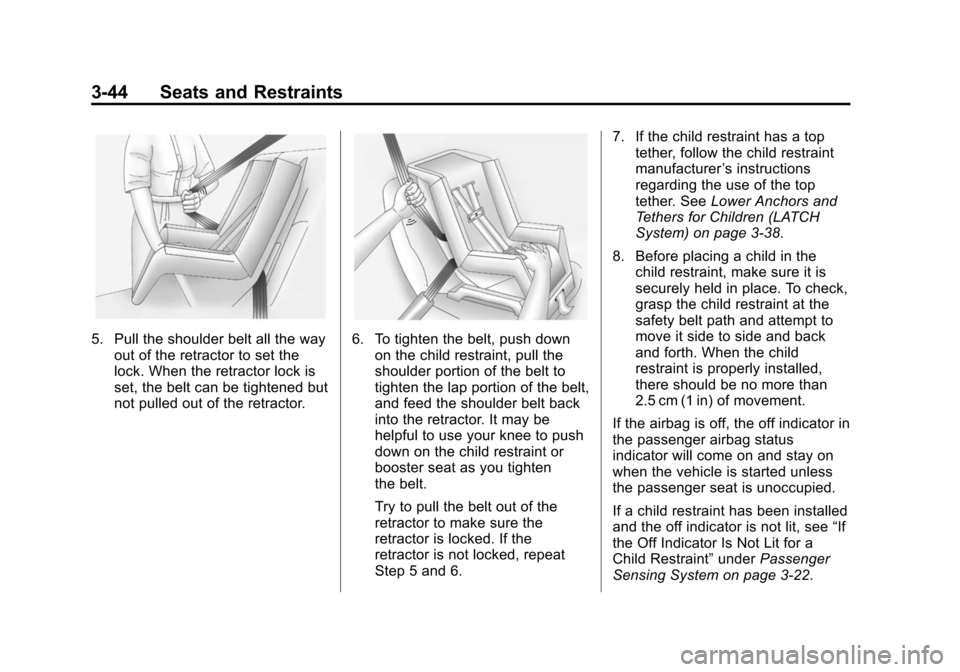
Black plate (44,1)Chevrolet City Express Owner Manual (GMNA-Localizing-U.S./Canada-
7707496) - 2015 - CRC - 11/26/14
3-44 Seats and Restraints
5. Pull the shoulder belt all the wayout of the retractor to set the
lock. When the retractor lock is
set, the belt can be tightened but
not pulled out of the retractor.6. To tighten the belt, push downon the child restraint, pull the
shoulder portion of the belt to
tighten the lap portion of the belt,
and feed the shoulder belt back
into the retractor. It may be
helpful to use your knee to push
down on the child restraint or
booster seat as you tighten
the belt.
Try to pull the belt out of the
retractor to make sure the
retractor is locked. If the
retractor is not locked, repeat
Step 5 and 6. 7. If the child restraint has a top
tether, follow the child restraint
manufacturer ’s instructions
regarding the use of the top
tether. See Lower Anchors and
Tethers for Children (LATCH
System) on page 3-38.
8. Before placing a child in the child restraint, make sure it is
securely held in place. To check,
grasp the child restraint at the
safety belt path and attempt to
move it side to side and back
and forth. When the child
restraint is properly installed,
there should be no more than
2.5 cm (1 in) of movement.
If the airbag is off, the off indicator in
the passenger airbag status
indicator will come on and stay on
when the vehicle is started unless
the passenger seat is unoccupied.
If a child restraint has been installed
and the off indicator is not lit, see “If
the Off Indicator Is Not Lit for a
Child Restraint” underPassenger
Sensing System on page 3-22.
Page 84 of 297
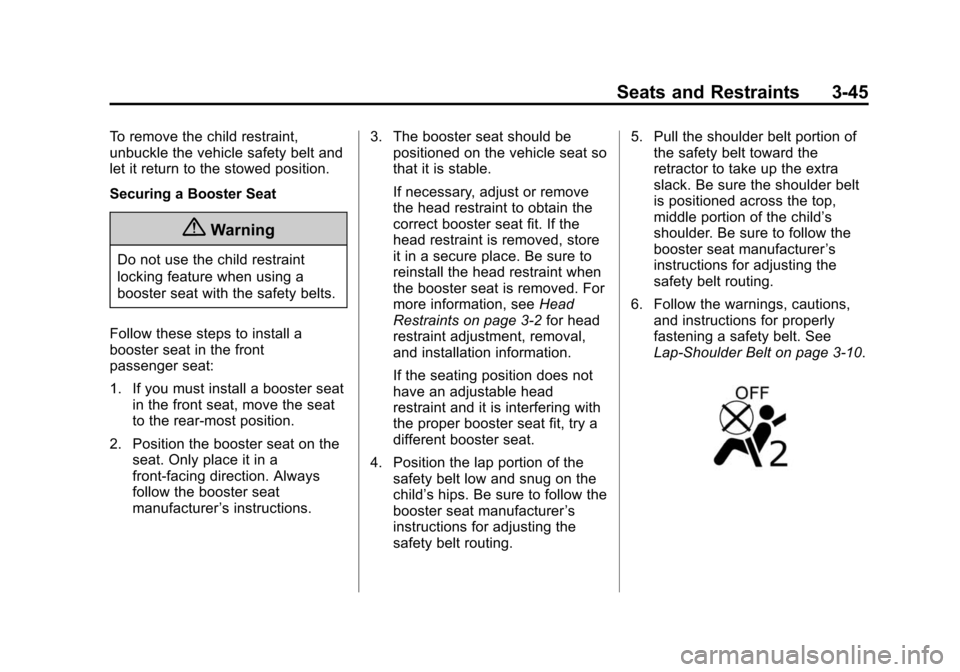
Black plate (45,1)Chevrolet City Express Owner Manual (GMNA-Localizing-U.S./Canada-
7707496) - 2015 - CRC - 11/26/14
Seats and Restraints 3-45
To remove the child restraint,
unbuckle the vehicle safety belt and
let it return to the stowed position.
Securing a Booster Seat
{Warning
Do not use the child restraint
locking feature when using a
booster seat with the safety belts.
Follow these steps to install a
booster seat in the front
passenger seat:
1. If you must install a booster seat in the front seat, move the seat
to the rear-most position.
2. Position the booster seat on the seat. Only place it in a
front-facing direction. Always
follow the booster seat
manufacturer ’s instructions. 3. The booster seat should be
positioned on the vehicle seat so
that it is stable.
If necessary, adjust or remove
the head restraint to obtain the
correct booster seat fit. If the
head restraint is removed, store
it in a secure place. Be sure to
reinstall the head restraint when
the booster seat is removed. For
more information, see Head
Restraints on page 3-2 for head
restraint adjustment, removal,
and installation information.
If the seating position does not
have an adjustable head
restraint and it is interfering with
the proper booster seat fit, try a
different booster seat.
4. Position the lap portion of the safety belt low and snug on the
child’s hips. Be sure to follow the
booster seat manufacturer ’s
instructions for adjusting the
safety belt routing. 5. Pull the shoulder belt portion of
the safety belt toward the
retractor to take up the extra
slack. Be sure the shoulder belt
is positioned across the top,
middle portion of the child’s
shoulder. Be sure to follow the
booster seat manufacturer ’s
instructions for adjusting the
safety belt routing.
6. Follow the warnings, cautions, and instructions for properly
fastening a safety belt. See
Lap-Shoulder Belt on page 3-10.
Page 85 of 297

Black plate (46,1)Chevrolet City Express Owner Manual (GMNA-Localizing-U.S./Canada-
7707496) - 2015 - CRC - 11/26/14
3-46 Seats and Restraints
7. If the booster seat is installed inthe front passenger seat, place
the ignition switch in the ON
position. The passenger airbag
status indicator may or may not
be lit, depending on the size of
the child and the type of booster
seat being used. For more
information, see Passenger
Airbag Status Indicator on
page 5-10.
Page 87 of 297
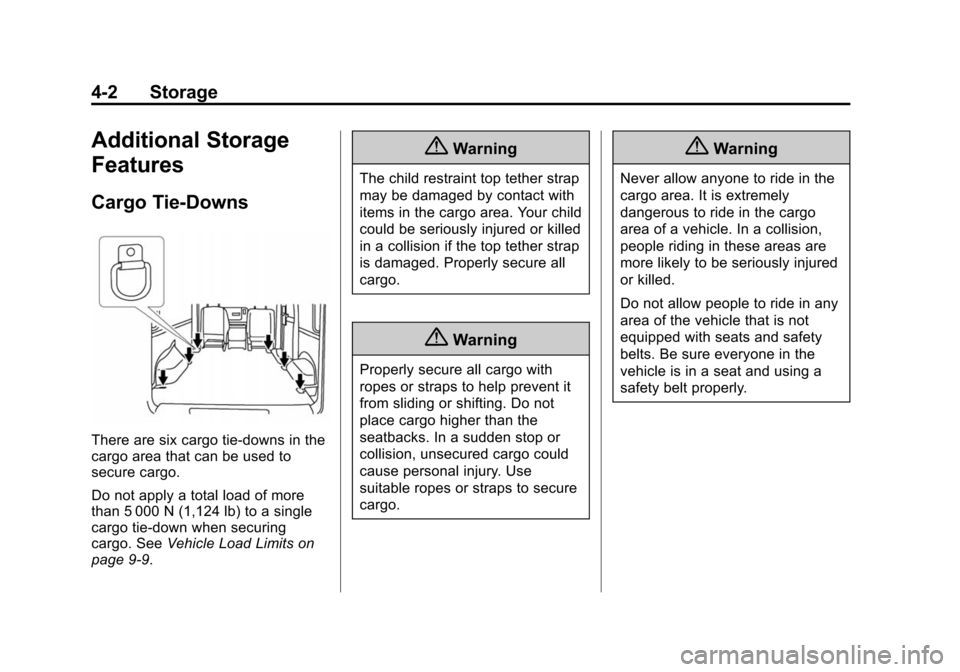
Black plate (2,1)Chevrolet City Express Owner Manual (GMNA-Localizing-U.S./Canada-
7707496) - 2015 - CRC - 11/26/14
4-2 Storage
Additional Storage
Features
Cargo Tie-Downs
There are six cargo tie-downs in the
cargo area that can be used to
secure cargo.
Do not apply a total load of more
than 5 000 N (1,124 lb) to a single
cargo tie-down when securing
cargo. SeeVehicle Load Limits on
page 9-9.
{Warning
The child restraint top tether strap
may be damaged by contact with
items in the cargo area. Your child
could be seriously injured or killed
in a collision if the top tether strap
is damaged. Properly secure all
cargo.
{Warning
Properly secure all cargo with
ropes or straps to help prevent it
from sliding or shifting. Do not
place cargo higher than the
seatbacks. In a sudden stop or
collision, unsecured cargo could
cause personal injury. Use
suitable ropes or straps to secure
cargo.
{Warning
Never allow anyone to ride in the
cargo area. It is extremely
dangerous to ride in the cargo
area of a vehicle. In a collision,
people riding in these areas are
more likely to be seriously injured
or killed.
Do not allow people to ride in any
area of the vehicle that is not
equipped with seats and safety
belts. Be sure everyone in the
vehicle is in a seat and using a
safety belt properly.